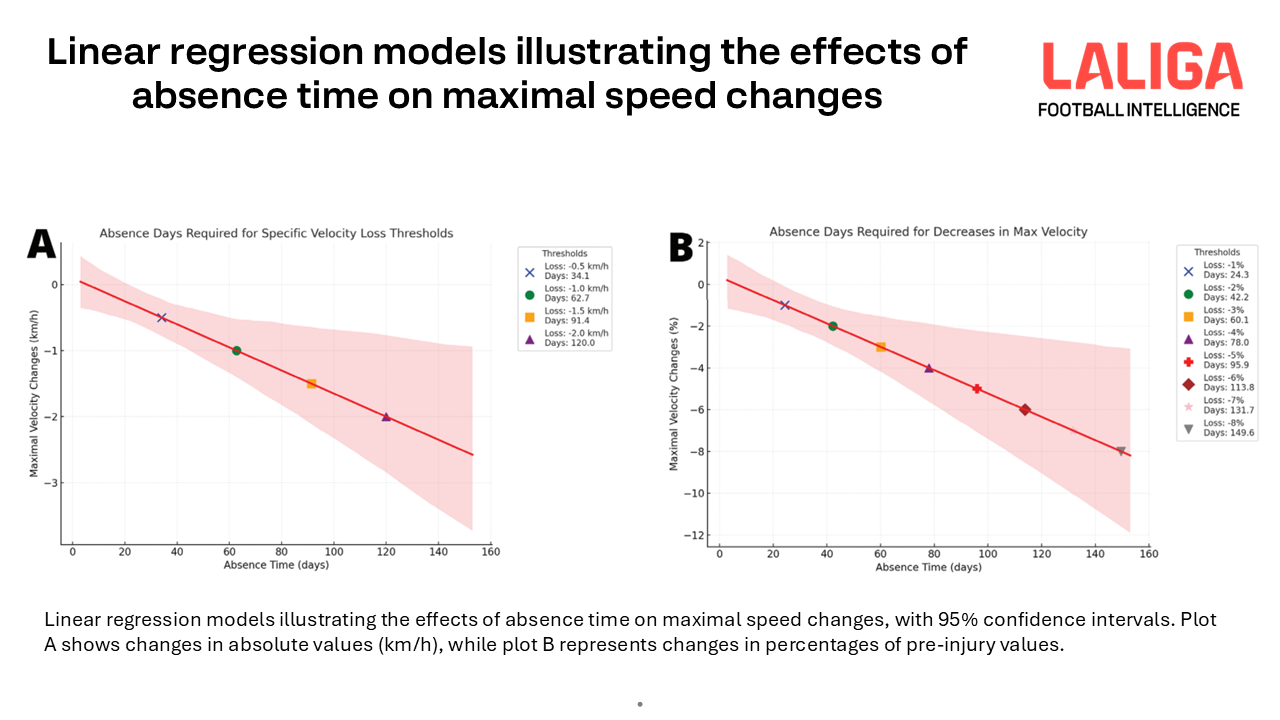
30 Jun “You’re cleared to play… but are you ready to perform?”
What science says about how injury absence time impacts real match running performance in professional footballers
When medical clearance isn’t enough
A player walks out of the tunnel. He’s spent the past weeks working against the clock: physiotherapy, gym sessions, individual drills, functional tests. The medical team has cleared him. The coaching staff includes him in the squad. Everything seems ready. But as a coach, only one question really matters:
Is he ready to perform at the level the team needs?
This dilemma is all too common in professional football. It’s long been known that muscular injuries affect performance — but how much, in what way, and for how long? A new study based on real data from LALIGA offers some clear answers. And it raises new questions.
? Full paper available at: https://doi.org/10.5114/biolsport.2025.151651
What really happens when a player returns from a muscle injury?
Researchers from the University of Seville and LALIGA’s Football Intelligence Department analyzed 110 real cases of muscular injuries (hamstrings, quadriceps, calves, adductors) sustained during the 2022/23 season. But they didn’t just look at whether players returned to play. They went further: comparing each player’s physical match performance in the four games prior to injury and the four following their return.
Using machine learning models, the study identified which physical metrics were most sensitive to time lost. And the results are as solid as they are useful.
The longer the layoff, the greater the loss in what matters most
The findings are clear: maximum sprint speed is the most affected variable when a player has spent several weeks out. Close behind are the ability to accelerate and decelerate explosively. In other words, the three physical abilities most critical for influencing the modern game — especially off the ball.
There’s an important nuance, though: the number of sprints per match was not directly related to the duration of the absence. Does that mean players exert the same effort? Not quite. They may attempt similar behaviors, but with reduced effectiveness: slower top speed, reduced burst, diminished capacity to stop abruptly.
Less real impact.
And in elite football, that makes all the difference.
What does recent research say?
These results are consistent with previous studies. For instance, Portillo et al. (2020) found players could lose up to 2.78 km/h in top speed and 8.6% in sprint distance after returning from injury. Whiteley et al. (2022) observed average losses of 43 meters in high-speed running and 22 meters in sprinting — even with injuries that had median absence times of just 14 days.
Encouragingly, most players recover pre-injury levels of physical performance within 11 to 14 days after returning to competition, especially following mild injuries (Hoppen et al., 2022; Estévez-Rodríguez et al., 2024). But when the absence is longer — due to tendon involvement or reinjury — full recovery can take significantly more time. And the risk of recurrence increases.
What should you do differently as a coach?
This kind of evidence doesn’t just deepen our understanding — it helps make better decisions. So, how can you apply it?
1. Don’t treat a 10-day absence like a 40-day one
Even if both players are “available,” their physical capacities may be at very different stages. Adjust roles and loads based on actual time out.
2. Look beyond the medical clearance
Incorporate testing for maximum speed, acceleration, and deceleration before granting competitive minutes. If you have GPS data, compare it to the player’s pre-injury baseline.
3. Use progressive reintroduction of sprint demands
Remember: over 80% of sprints in football are curved or end in technical-tactical actions. Recreate these demands with specific, contextual tasks.
4. Monitor braking ability
Multiple studies highlight that intense deceleration is one of the most relevant risk factors post-injury. Don’t underestimate its importance.
Returning to play is not returning to perform
This statement should be a constant reminder in every return-to-play plan. Medical clearance is just the entry point. True recovery only happens when the player regains their peak physical performance in a competitive environment. And as this study — and others — show, that doesn’t always happen immediately.
References
- Estévez-Rodríguez, J., Rivilla-García, J., & Jiménez-Rubio, S. (2024). Is it possible to improve performance in competition after an adductor longus injury in professional football players? Journal of Sport Rehabilitation. https://doi.org/10.1123/jsr.2024-0028
- Hoppen, M. I., Reurink, G., de Boode, V. A., van der Kaaden, L., Jagtman, L., Glazenburg, T., Bruning, B., & Tol, J. (2022). Return to match running performance after a hamstring injury in elite football: A single-centre retrospective cohort study. BMJ Open Sport & Exercise Medicine, 8(1), e001240. https://doi.org/10.1136/bmjsem-2021-001240
- Mendiguchia, J., Samozino, P., Martínez-Ruiz, E., Brughelli, M., Schmikli, S., Morin, J.-B., & Méndez-Villanueva, A. (2014). Progression of mechanical properties during on-field sprint running after returning to sports from a hamstring muscle injury in soccer players. International Journal of Sports Medicine, 35(8), 651–659. https://doi.org/10.1055/s-0033-1363192
- Portillo, J., Abián, P., Calvo, B., Paredes, V., & Abián-Vicén, J. (2020). Effects of muscular injuries on the technical and physical performance of professional soccer players. The Physician and Sportsmedicine, 48(3), 301–306. https://doi.org/10.1080/00913847.2020.1744485
- Raya-González, J., García-Calvo, T., Rojas-Valverde, D., López del Campo, R., Resta, R., & Díaz-García, J. (2023). Understanding the impact of hamstring injuries on match performance in Spanish professional soccer players. Kinesiology, 55(2), 18–30. https://doi.org/10.26582/k.55.2.18
- Whiteley, R., Gregson, W., Bahr, R., Tabben, M., Chamari, K., Lolli, L., & D. Salvo, V. (2022). High-speed running during match-play before and after return from hamstring injury in professional footballers. Scandinavian Journal of Medicine & Science in Sports, 32(10), 1505–1514. https://doi.org/10.1111/sms.14219


